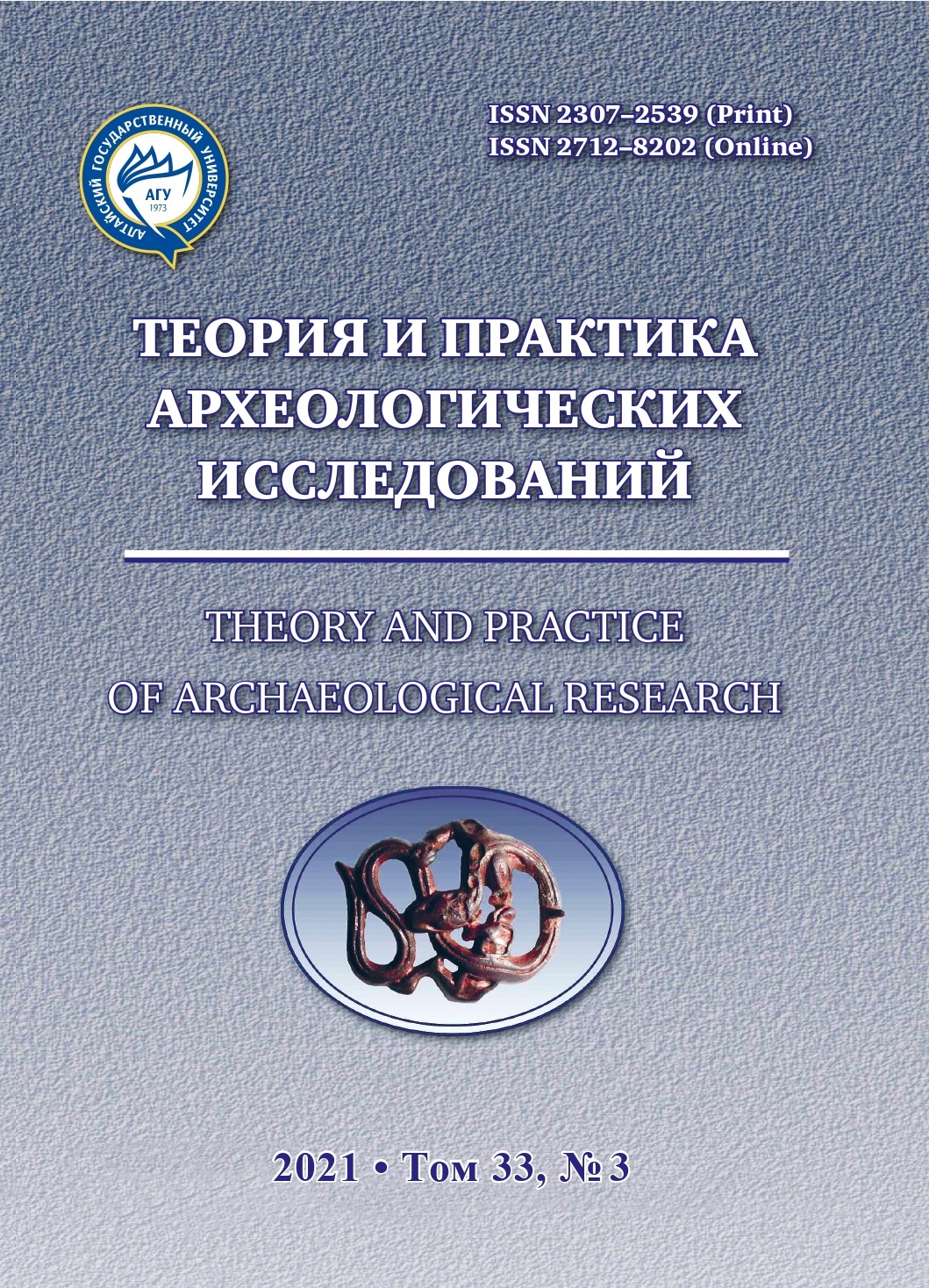ВОЗНИКНОВЕНИЕ МИКРОЛИТИЧЕСКОГО ПРОИЗВОДСТВА В МОНГОЛИИ: ИССЛЕДОВАТЕЛЬСКАЯ ТЕРМИНОЛОГИЯ И ХРОНОСТРАТИГРАФИЧЕСКАЯ ПОЗИЦИЯ ИНДУСТРИЙ В ВЕРХНЕМ ПАЛЕОЛИТЕ ВОСТОЧНОЙ И ЮЖНОЙ ЧАСТИ АЗИИ
Аннотация
На территории Монголии, находящейся в центре Азии на перекрестке потенциальных миграционных путей, связывающих различные макрорегионы Евразии, фиксируется пример раннего возникновения и долгого существования мелкопластинчатой и микро-пластинчатой традиции расщепления. Кроме того, в конце морской изотопной стадии 3 и начале морской изотопной стадии 2 на ограниченной территории в пределах среднего течения Селенги в седиментах стоянок Толбор-4, 16 и 21 засвидетельствовано наиболее раннее в Центральной Азии появление индустрий, содержащих микролиты. Их существование пресекается в период последнего ледникового максимума, связанного с возможной депопуляцией территории и последующей сменой населения. Понимание характера, причин и особенностей столь раннего появления производства микропластин и пластинок и собственно микролитов требует систематизации и определения терминологии, относящейся к микролитическим ассамбляжам на территории Азии. Это вызвано тем, что в археологических дефинициях как процессов, так и желаемых форм артефактов, связанных с производством и использованием микролитов, существуют значительные разночтения, затрудняющие понимание описываемых явлений. В статье приводится обзор исследовательской терминологии процессов микролитизации, а также определяется положение микролитических комплексов Монголии в системе верхнего палеолита восточной части Азии.
Скачивания
Metrics
No metrics found.
Литература
Abramova Z. A. Paleolit Eniseya. Afontovskaya kul’tura. [Paleolithic of Enisey. Afontova Culture]. Novosibirsk : Nauka, 1979. 156 p. (In Russ.)
Akimova E. V. Rannesartanskaya industriya melkih plastin v finale pozdnego paleolita Srednego Eniseya: k probleme formirovaniya arheologicheskih refugiumov [Early Sartan Small Blade Industry in the Final Late Paleolithic of Middle Yenisei: the Problem of Archaeological Refugium Forming]. Problemy biologicheskoj i kulturnoj adaptacii chelovecheskih populyacij. T. 1: Arheologiya. Adaptacionnye strategii drevnego naseleniya Severnoj Evrazii: syr’e i priyomy obrabotki [Problems of Biological and Cultural Adaptation of Human Populations. Vol. 1: Archaeology. Adaptation Strategies of the Ancient Population of Northern Eurasia: Raw Materials and Processing Techniques]. SPb. : Nauka, 2008. Pp. 37–47. (In Russ.)
An Zh. The Mesolithic Remains in Hailar — Also on the the Origin and the Tradition of Microliths. Kaogu Xuebao (Chinese Journal of Archaeology). 1978. Vol. 3. Pp. 289–316.
Belfer-Cohen A., Goring-Morris A. N. Why Nicroliths? Microlithization in the Levant. Thinking Small: Global Per-spectives on Microlithic Technologies. Arlington : AP3A, 2002. Pp. 57–68.
Blinkhorn J. Buddha Pushkar Revisited: Technological Variability in Late Palaeolithic Stone Tools at the Thar Desert Margin, India. Journal of Archaeological Science: Reports. 2018. Vol. 20. Pp. 168–182.
Boëda E., Bonilauri S. The Intermediate Paleolithic : the First Bladelet Production 40,000 Years Ago. Anthropologie-International Journal of Human Diversity and Evolution. 2006. Vol.44 (1). Pp. 75–92.
Boëda E., Bonilauri S., Kaltnecker E., Valladas H., Al-Sakhel H. Un débitage lamellaire au Proche-Orient vers 40 000 ans cal BP. Le site d’Umm el Tlel, Syrie central // L’anthropologie. 2015. Vol. 119. Pp. 141–169.
Bon. F. A Brief Overview of Aurignacian Cultures in the Context of the Industries of the Transition from the Middle to the Upper Paleolithic. Towards a Definition of the Aurignacian. Lisbon: Instituto Português de Arqueologia (Trabalhos de Arqueologia 45). 2006. Pp. 133–144.
Brunet, F. The Technique of Pressure Knapping in Central Asia: Innovation or Diffusion? The Emergence of Pressure Blade Making: From Origin to Modern Experimentation. Québec : Springer, 2012. Pp. 307–328.
Chen Ch., Wang X.–Q. Upper Paleolithic Microblade Industries in North China and Their Relationships with Northeast Asia and North America. Arctic Anthropology. 1989. Vol. 2(26). Pp. 127–156.
Clarkson C., Hiscock P., Mackay A., Shipton C. Small, Sharp, and Standardized: Global Convergence in Backed-Microlith Technology. Convergent Evolution in Stone-Tool Technology. Cambridge : MIT Press, 2018. Pp. 175–200.
Clarkson C., Petraglia M., Korisettar R., Haslam M., Boivin N., Crowther A., et al. The Oldest and Longest Enduring Microlithic Sequence in India: 35 000 Years of Modern Human Occupation and Change at the Jwalapuram Locality 9 Rockshelter. Antiquity. 2009. Vol. 83(320). Pp. 326–348.
Derevianko A. P., Petrin V. T., Rybin E. P., Chevalkov L. M. Paleoliticheskie komplexy stratificirovannoy chasti stoyanki Kara-Bom (mustye i verkhniy paleolit) [Paleolithic Complexes of the Stratified Part of the Kara-Bom Site Mousterian/Upper Paleolithic]. Novosibirsk : IAET, 1998. 235 p. (In Russ., English, French).
Derevianko A. P., Zenin A. N., Rybin E. P., Gladyshev S. A., Tsybankov A. A., Olsen J. W., Tseveendorj D., Gunchinsuren, B. The Technology of Early Upper Paleolithic Lithic Reduction in Northern Mongolia: the Tolbor-4 site. Archaeology, Ethnology and Anthropology of Eurasia. 2007. Vol. 29. Pp. 16–38.
Faivre J.-Ph. A Material Anecdote but Technical Reality: Bladelet and Small Blade Production during the Recent Middle Paleolithic at Combe-Grenal Rock Shelter. Lithic Technology. 2012. Vol. 37. Pp. 5–25.
Gladyshev S. A. Svidetel’stva primeneniya tehniki mikrorasshchepleniya v kompleksah rannego verhnego paleolita mnogoslojnyh stratificirovannyh stoyanok Gobijskogo Altaya [Evidence of Micropercussion Technique in the Complexes of the Early Upper Paleolithic at the Multilayered Stratified Sites in the Gobi Altai]. Problemy arheologii, etnografii, antropologii Sibiri i sopredel’nyh territorij [Problems of Archaeology, Ethnography and Anthropology of Siberia and Neighboring territories]. Novosibirsk : Izd-vo In-ta arheologii i etnografii SO RAN, 2017. Vol. 23. Pp. 202–205 (In Russ.).
Gladyshev S. A., Tabarev A. V. Nekotorye problemy izucheniya mikroplastinchatogo rasshchepleniya v rannem verhnem paleolite Severnoj Mongolii [Some Problems of Studies of Microblade Percussion in the Early Upper Paleolithic of Norhtern Mongolia]. Teoriya i praktika arheologicheskih issledovanij [Theory and Practice of Archaeological Research]. 2017. Vol. 17 (1). Pp. 154–166. (In Russ.)
Gladyshev S. А., Tabarev А. V. Mikroplastinchatoe rasshcheplenie v rannem verhnem paleolite Mongolii [Microblade Production in the Early Upper Paleolithic of Mongolia]. Stratum Plus : Archaeology and Cultural Anthropology. 2018. No. 1. Pp. 339–351. (In Russ.)
Gómez Coutouly Y. A. The emergence of pressure knapping microblade technology in Northeast Asia. Radiocarbon. 2018. Vol. 60. Pp. 821–855.
Inizan M.-L., Reduron-Ballinger M., Roche H., Tixier J. Technology and Terminology of Knapped Stone. Nanterre : C.R.E.P., 1999. 191 p.
Keates S. G., Postnov A. V., Kuzmin, Y. V. Towards the Origin of Microblade Technology in Northeastern Asia. Vestnik of Saint Petersburg University. History. 2019. Vol. 64. Pp. 390–414.
Kharevich V. M., Akimova E. V., Stasyuk I. V., Tomilova E. A. Tehnologiya proizvodstva plastin v kamennoj industrii kul’turnogo sloya 19 stoyanki Listvenka [Blade Production Technology in the Industry of Layer 19 of the Listvenka Site]. Stratum Plus. Cultural Anthropology and Archaeology. 2015. No. 1. Pp. 321–331. (In Russ.)
Kolobova K. A., Flas D., Derevianko A. P., Pavlenok K. K., Islamov U. I., Krivoshapkin A. I. The Kulbulak Bladelet Tradition in The Upper Paleolithic of Central Asia. Archaeology, Ethnology and Anthropology of Eurasia. 2013. Vol. 41 (2). Pp. 2–25. https://doi.org/10.1016/j.aeae.2013.11.002.
Kolobova K. A., Krivoshapkin A. I., Derevyanko A. P., Islamov U. I. Dodekatym-2 Paleolithic site (Uzbekistan) // Archaeology, Ethnology, and Anthropology of Eurasia. 2011. Vol. 48 (4). Pp. 2–12.
Krivoshapkin A., Kuzmin Y., Jull A. J. Chronology of the Obi-Rakhmat Grotto (Uzbekistan): First Results on the Dating and Problems of the Paleolithic Key Site in Central Asia // Radiocarbon. 2010. Vol. 52 (2–3). Рp. 549–554.
Kuhn S., Elston R. G. Introduction: Thinking Small Globally. Thinking Small: Global Perspectives on Microlithization. Archaeological Paper No. 12. Washington : American Anthropological Association, 2002. Pp. 1–8.
Lisitsyn N. F. Pozdnij paleolit Chulymo-Enisejskogo mezhdurech’ya [Late Paleolithic of Chulym-Enisej Interfluve]. Trudy IIMK RAN [Proceedings of the IIMK RAN]. Sankt-Petersburg : Peterb. vostokovedenie, 2000. Vol. 2. 230 p. (In Russ.)
Lisitsyn N. F. Srednij etap pozdnego paleolita Sibiri [Middle Stage of Siberian Late Paleolithic]. Rossijskaya arheologiya. 1996. No4. Pp. 5–17. (In Russ.)
Mao X., Zhang H., Qiao S., Liu Y., Chang F., Xie P., Zhang M., Wang T., Li M., Cao P., Yang R., Liu F., Dai Q., Feng X., Ping W., Lei C., Olsen J. W., Bennett E. A., Fu Q. The Deep Population History of Northern East Asia from the Late Pleistocene to the Holocene. Cell. 2021. Vol. 184. Pp. 1–11. https://doi.org/10.1016/j.cell.2021.04.040.
Mellars P. Why Did Modern Human Populations Disperse from Africa 60,000 Years Ago? A New Model. Proceedings of the National Academy of Sciences. 2006. Vol. 103. P. 9381.
Mishra S., Chauhan N., Singhvi A. K. Continuity of Microblade Technology in the Indian Subcontinent Since 45 ka: Implications for the Dispersal of Modern Humans. PLoS ONE. 2013. Vol. 8(7) Pp. e69280. https://doi.org/10.1371/journal.pone.0069280
Morlan R. E. Wedge-shaped Core Technology in Northern North America. Arctic Anthropology. 1970. Vol. 7(2). Pp. 17–37.
Nakazawa Y., Akai F. Late-Glacial Bifacial Microblade Core Technologies in Hokkaido: An Implication of Human Adaptation along the Northern Pacific Rim. Quaternary International. 2017. Vol. 442. Pp. 43–54. https://doi: 10.1016/j.quaint.2016.07.019.
Nakazawa Y., Izuho M., Takakura J., Yamada S. Toward an Understanding of Technological Variability in Microblade Assemblages in Hokkaido. Japan. Asian Perspectives. 2005. Vol. 44. Pp. 276–292.
Pargeter J. Lithic Miniaturization in Late Pleistocene Southern Africa. Journal of Archaeological Science: Reports. 2016. Vol. 1010. Pp. 221–236.
Pastoors A., Tafelmaier Y. Bladelet Production, Core Reduction Strategies, and Efficiency of Core Configuration at the Middle Palaeolithic site Balver Höhle (North Rhine Westphalia, Germany). Quartär. 2010. Vol. 57. Pp. 25–41.
Pavlenok G. D. Tehnologiya izgotovleniya klinovidnyh nukleusov v selenginskoj kul’ture Zapadnogo Zabajkal’ya (po materialam stoyanki Ust’-Kyahta-3) [Technology of Wedge-Shaped Cores Production in the Selenga Culture of Western Tansbaikalia]. Izvestiya Altajskogo gosudarstvennogo universiteta. Ser.: Istoricheskie nauki i arheologiya. 2015. No. 3/2 (87). Pp. 178–184. (In Russ.)
Pelegrin J. Blade Making Techniques from the Old World: Insights and Applications to Mesoamerican Obsidian Lithic Technology. Mesoamerican Lithic Technology: Experimentation and Interpretation. Salt Lake City : The University of Utah Press, 2003. Pp. 55–71.
Rybin E. P., Khatsenovich A. M., Zwins N., Gunchinsurehn B., Paine С., Bolorbat Ts., Anojkin A. A., Kharevich V. M., Odsuren D., Margad-Erdene G. Stratigrafiya i kul’turnaya posledovatel’nost’ stoyanki Tolbor-21 (Severnaya Mongoliya): itogi rabot 2014–2016 godov i dal’nejshie perspektivy issledovanij [Stratigraphy and Cultural Sequence of the Tolbor 21 Site (Northern Mongolia): the Results of the 2014–2016 Excavation Campaigns and Perspectives of Further Investigations]. Teoriya i praktika arheologicheskih issledovanij [Theory and Practice of Archaeological Research]. 2017. Vol. 15. No. 4 (20). Pp. 158–168. (In Russ.)
Sato H., Tsutsumi T. The Japanese Microblade Industries: Technology, Raw Material Procurement, and Adaptations. Origin and Spread of Microblade Technology in Northern Asia and North America. Burnaby (BC) : Archaeology Press, Simon Fraser University, 2007. Pp. 57–78.
Sollberger J. B., Patterson L. W. Prismatic Blade Replication. American Antiquity. 1976. Vol. 41. Pp. 517–531.
Song Y., Grimaldi S., Santaniello F., Cohen D. J., Shi J., Bar-Yosef O. Re-thinking the Evolution of Microblade Technology in East Asia: Techno-Functional Understanding of the Lithic Assemblage from Shizitan 29 (Shanxi, China). PLoS One. 2019. Vol. 14 (2). P. e0212643.
Soriano S., Villa P., Wadley L. Blade Technology and Tool Forms in the Middle Stone Age of South Africa: the Howiesons Poort and Post-Howiesons Poort at Rose Cottage Cave. Journal of Archaeological Science. 2007. Vol. 34 (2007). Pp. 681–703.
Takakura J. Emergence and Development of the Pressure Microblade Production: a View from the Upper Paleolithic of Northern Japan. The Emergence of Pressure Blade Making. Québec : Springer, 2012. Pp. 285–306.
Taylor W. E. A Distinction between Blades and Microblades in the American Arctic. American Antiquity. 1962. Vol. 27. Pp. 425–426.
Tixier J. Typologie de l’Epipaléolithique du Maghreb. Mémoires du Centre de Recherches anthropologiques et préhistoriques et ethnographiques 2. Paris : Arts et Métiers graphiques,1963. 212 p.
Wedage O., Picin A., Blinkhorn J., Douka K., Deraniyagala S., Kourampas N., Perera N., Simpson I., Boivin N., Petraglia M., Roberts P. Microliths in the South Asian Rainforest~45–4 ka: New Insights from Fa-Hien Lena Cave, Sri Lanka. PLoS ONE. 2019. Vol. 14(10).P. e0222606. https://doi.org/10.1371/journal.pone.0222606
Zwyns N., Gladyshev S. A., Gunchinsuren B., Bolorbat T., Flas D., Tabarev A. V., Dogandzic T., Gillam G. C., Khatsenovich A. M., Odsuren D., Purevjal K.‐E., Richards M., Stewart J., Talamo S. The Open-Air Site of Tolbor 16 (Northern Mongolia): Preliminary Results and Perspectives. Quaternary International. 2014. Vol. 347. Pp. 53–65.
Zwyns N., Rybin E. P., Hublin J.‐J., Derevianko A. P. Burin-Core Technology and Laminar Reduction Sequence in the Initial Upper Paleolithic from Kara-Bom (Gorny-Altai, Siberia).Quaternary International. 2012. Vol. 259. P. 33–47.
Авторы, публикующиеся в данном журнале, соглашаются со следующими условиями:
a. Авторы сохраняют за собой права на авторство своей работы и предоставляют журналу право первой публикации этой работы с правом после публикации распространять работу на условиях лицензии Creative Commons Attribution License, которая позволяет другим лицам свободно распространять опубликованную работу с обязательной ссылокой на авторов оригинальной работы и оригинальную публикацию в этом журнале.
b. Авторы сохраняют право заключать отдельные договора на неэксклюзивное распространение работы в том виде, в котором она была опубликована этим журналом (например, размещать работу в электронном архиве учреждения или публиковать в составе монографии), с условием сохраниения ссылки на оригинальную публикацию в этом журнале. с. Политика журнала разрешает и поощряет размещение авторами в сети Интернет (например в институтском хранилище или на персональном сайте) рукописи работы как до ее подачи в редакцию, так и во время ее редакционной обработки, так как это способствует продуктивной научной дискуссии и положительно сказывается на оперативности и динамике цитирования статьи








2.jpg)




